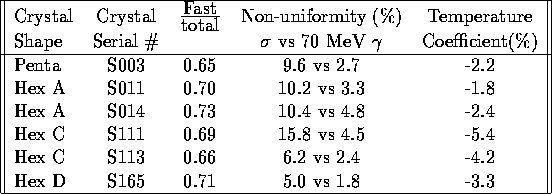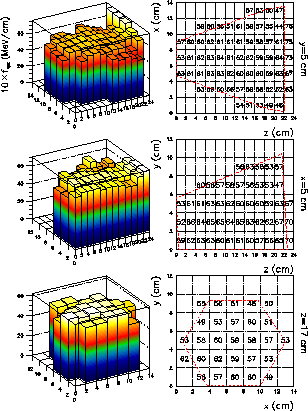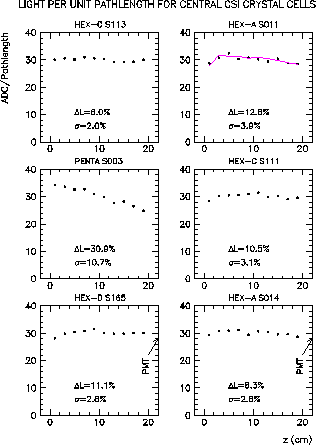



Next: Calorimeter Response to
Up: Cosmic Ray Tomography
Previous: Calibration of the
In order to determine the non-uniformity of the CsI light throughout the
volume of the modules, a reconstruction technique similar to that used
in nuclear medicine imaging is needed.
In the case of the pion beta tomography, the
directions and the pathlengths of the cosmic muons in the CsI modules are
obtained from the drift chambers. If the volume of a crystal is subdivided
into elementary cells, a cosmic muon traversing the module will deposit
energies in the cells which lie along the particle path. The energy
deposited depends on the segments of the particle's trajectory in
the cells. A geometrical algorithm has been designed to trace the particle's
trajectory through the crystals, and to find the number and the actual
pathlength in each of the cells traversed. However for a given cosmic ray,
only the total sum of the light outputs in the cells traversed is known
from the CsI ADC. The reconstruction method allows the determination of the
light per pathlength in the elementary cells of the CsI module, and enables
the study of the non-uniformity of the generation and collection of the CsI
light in the volume of the crystals.
The principle of the reconstruction
technique consists of taking initial guesses at the lights per pathlengths in
the elementary cells.

Table: Some parameters of the six crystal measured
with the tomography
system. The non-uniformity  in the fourth column is affected by the
light generated close to the PMT --- solid angle effect. When the non-uniformity
functions are weighted with the energies of the showers initiated by 70 MeV
in the fourth column is affected by the
light generated close to the PMT --- solid angle effect. When the non-uniformity
functions are weighted with the energies of the showers initiated by 70 MeV  's
incident along the crystal axes, the detector responses are more uniform. The temperature coefficients were calculated assuming a linear
dependence of the light output on the temperature. For the fast and the
total components, the ADC integration times were 100 ns and
's
incident along the crystal axes, the detector responses are more uniform. The temperature coefficients were calculated assuming a linear
dependence of the light output on the temperature. For the fast and the
total components, the ADC integration times were 100 ns and
 respectively.
respectively.
Then new guesses are taken based on the discrepancies
between the calculated light outputs (from the previous trial) and the
measured ones. An iterative process is then initiated until the process
converges. Four of the existing reconstruction techniques [Bud-74] have
tested for their convergences and their abilities to handle noisy data. The
four methods tested are the additive and multiplicative versions of the
algebraic reconstruction technique (ART), the simultaneous iterative
reconstruction (SIRT) and the least-square iterative approach. These
techniques have been tested with a sample of simulated data consisting of a
 signal riding on an isotropic background. In 500 iterations, the SIRT
reconstructed the data, especially the signal as a region of
signal riding on an isotropic background. In 500 iterations, the SIRT
reconstructed the data, especially the signal as a region of  intensity above
the uniform background
intensity above
the uniform background .
.

Figure: The light non-uniformity obtained from the
reconstruction procedure
for one CsI module (serial # S011) in the box. 28000 events with multiple
scattering angles  were considered for the reconstruction.
The volume of the elementary cells was
were considered for the reconstruction.
The volume of the elementary cells was  .
Three orthogonal cuts through the crystal are shown here, and the text
histograms display the average light outputs (MeV) in the cells. The average
energy deposited in the CsI by the cosmic muons is
.
Three orthogonal cuts through the crystal are shown here, and the text
histograms display the average light outputs (MeV) in the cells. The average
energy deposited in the CsI by the cosmic muons is  ,
while the most probable energy loss is 5.92 MeV/cm.
,
while the most probable energy loss is 5.92 MeV/cm.
Some results of the reconstruction are shown in figure  for
one of the modules in the box. Figure
for
one of the modules in the box. Figure  shows the light
non-uniformity along the axis of a set of six crystals in the box, and some
results of the tomography are summarized in table
shows the light
non-uniformity along the axis of a set of six crystals in the box, and some
results of the tomography are summarized in table  .
.

Figure: The light collection
non-uniformity along the axes of six crystals
measured with the tomography system. The cosmic rays with polar angles
 in axial strips of
in axial strips of  were analyzed.
The result of the reconstruction technique summed over the cells which
satisfy the same cuts is shown as the dashed line for the module S011.
were analyzed.
The result of the reconstruction technique summed over the cells which
satisfy the same cuts is shown as the dashed line for the module S011.
In conclusion the tomography apparatus is under stable operation and a
reconstruction technique has been worked out to examine each of the calorimeter
modules. Up to six crystals can be inserted in the apparatus at a time. It
takes about a week of data taking to collect enough statistics for one set of
crystals in the box. During that period another batch of six modules are
prepared and ready to be set-up for the tomography. As stated previously,
tomography data have been taken for forty-seven crystals to date. The results
presented here are likely to be improved upon with a refinement of the
reconstruction technique and the analysis of the data. The goal is to build the
calorimeter using modules with non-uniformity less than 
(section 7.6). The crystals of that quality are being selected through the tomography
method described here. For the responses of an array of twelve calorimeter modules
to monoenergetic beam of  's, a non-uniformity of
's, a non-uniformity of  --- this was
inferred from the surface treatment studies for a wrapping method
consisting of three layers of teflon and black paper at the front face
(see figure 8.4) --- has been used to obtain excellent agreement between
data and simulation (section 8.1.3). The tomography method reveals the
non-uniformity throughout the volumes of the modules, and consequently will
render the simulation of the experiment even more realistic.
--- this was
inferred from the surface treatment studies for a wrapping method
consisting of three layers of teflon and black paper at the front face
(see figure 8.4) --- has been used to obtain excellent agreement between
data and simulation (section 8.1.3). The tomography method reveals the
non-uniformity throughout the volumes of the modules, and consequently will
render the simulation of the experiment even more realistic.




Next: Calorimeter Response to
Up: Cosmic Ray Tomography
Previous: Calibration of the
Bernward Krause
Mon Jan 15 14:57:06 MET 1996

 in the fourth column is affected by the
light generated close to the PMT --- solid angle effect. When the non-uniformity
functions are weighted with the energies of the showers initiated by 70 MeV
in the fourth column is affected by the
light generated close to the PMT --- solid angle effect. When the non-uniformity
functions are weighted with the energies of the showers initiated by 70 MeV  's
incident along the crystal axes, the detector responses are more uniform. The temperature coefficients were calculated assuming a linear
dependence of the light output on the temperature. For the fast and the
total components, the ADC integration times were 100 ns and
's
incident along the crystal axes, the detector responses are more uniform. The temperature coefficients were calculated assuming a linear
dependence of the light output on the temperature. For the fast and the
total components, the ADC integration times were 100 ns and
 respectively.
respectively.



 signal riding on an isotropic background. In 500 iterations, the SIRT
reconstructed the data, especially the signal as a region of
signal riding on an isotropic background. In 500 iterations, the SIRT
reconstructed the data, especially the signal as a region of  intensity above
the uniform background
intensity above
the uniform background

 were considered for the reconstruction.
The volume of the elementary cells was
were considered for the reconstruction.
The volume of the elementary cells was  .
Three orthogonal cuts through the crystal are shown here, and the text
histograms display the average light outputs (MeV) in the cells. The average
energy deposited in the CsI by the cosmic muons is
.
Three orthogonal cuts through the crystal are shown here, and the text
histograms display the average light outputs (MeV) in the cells. The average
energy deposited in the CsI by the cosmic muons is  ,
while the most probable energy loss is 5.92 MeV/cm.
,
while the most probable energy loss is 5.92 MeV/cm.

 in axial strips of
in axial strips of  were analyzed.
The result of the reconstruction technique summed over the cells which
satisfy the same cuts is shown as the dashed line for the module S011.
were analyzed.
The result of the reconstruction technique summed over the cells which
satisfy the same cuts is shown as the dashed line for the module S011.
 's, a non-uniformity of
's, a non-uniformity of  --- this was
inferred from the surface treatment studies for a wrapping method
consisting of three layers of teflon and black paper at the front face
(see figure 8.4) --- has been used to obtain excellent agreement between
data and simulation (section 8.1.3). The tomography method reveals the
non-uniformity throughout the volumes of the modules, and consequently will
render the simulation of the experiment even more realistic.
--- this was
inferred from the surface treatment studies for a wrapping method
consisting of three layers of teflon and black paper at the front face
(see figure 8.4) --- has been used to obtain excellent agreement between
data and simulation (section 8.1.3). The tomography method reveals the
non-uniformity throughout the volumes of the modules, and consequently will
render the simulation of the experiment even more realistic.